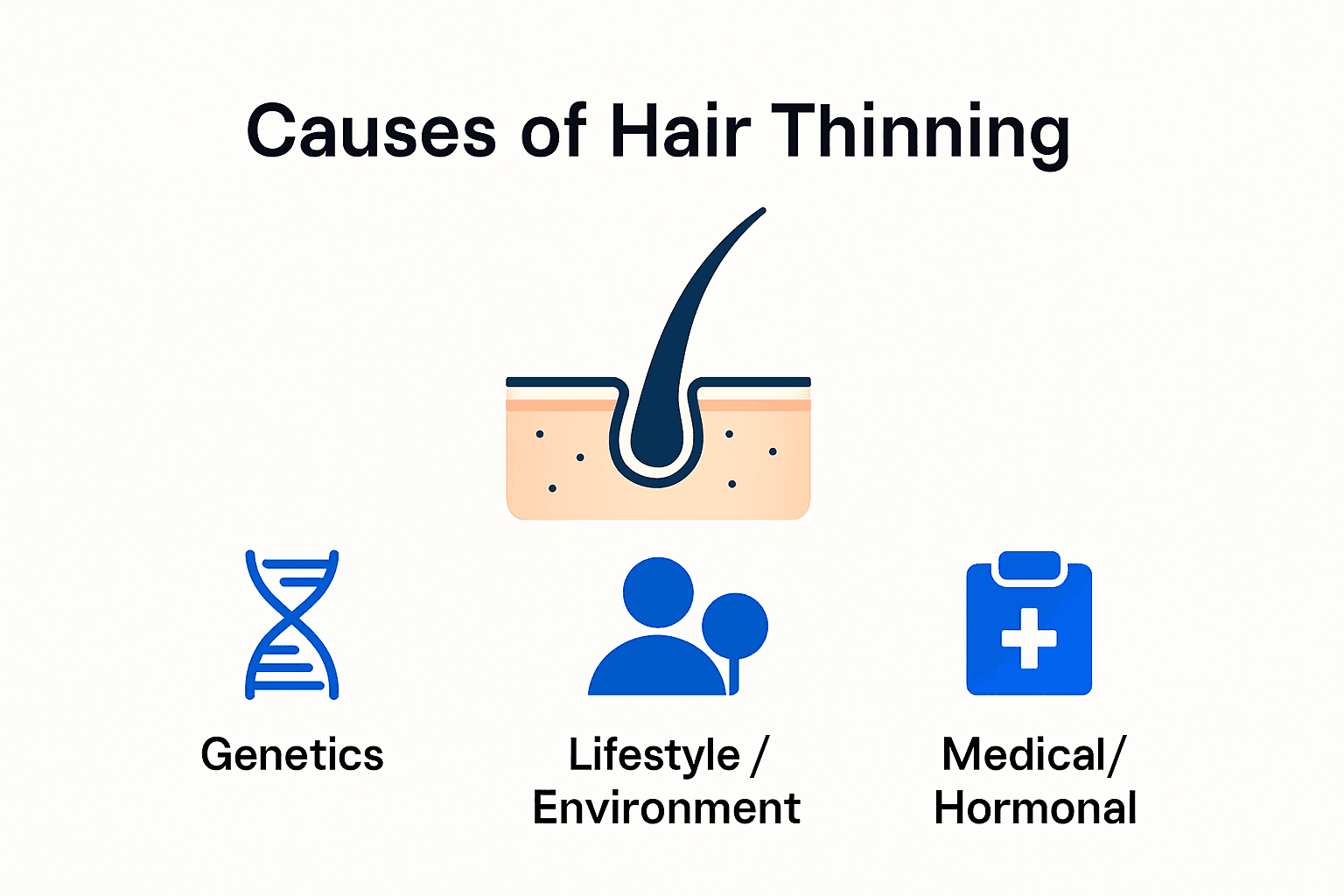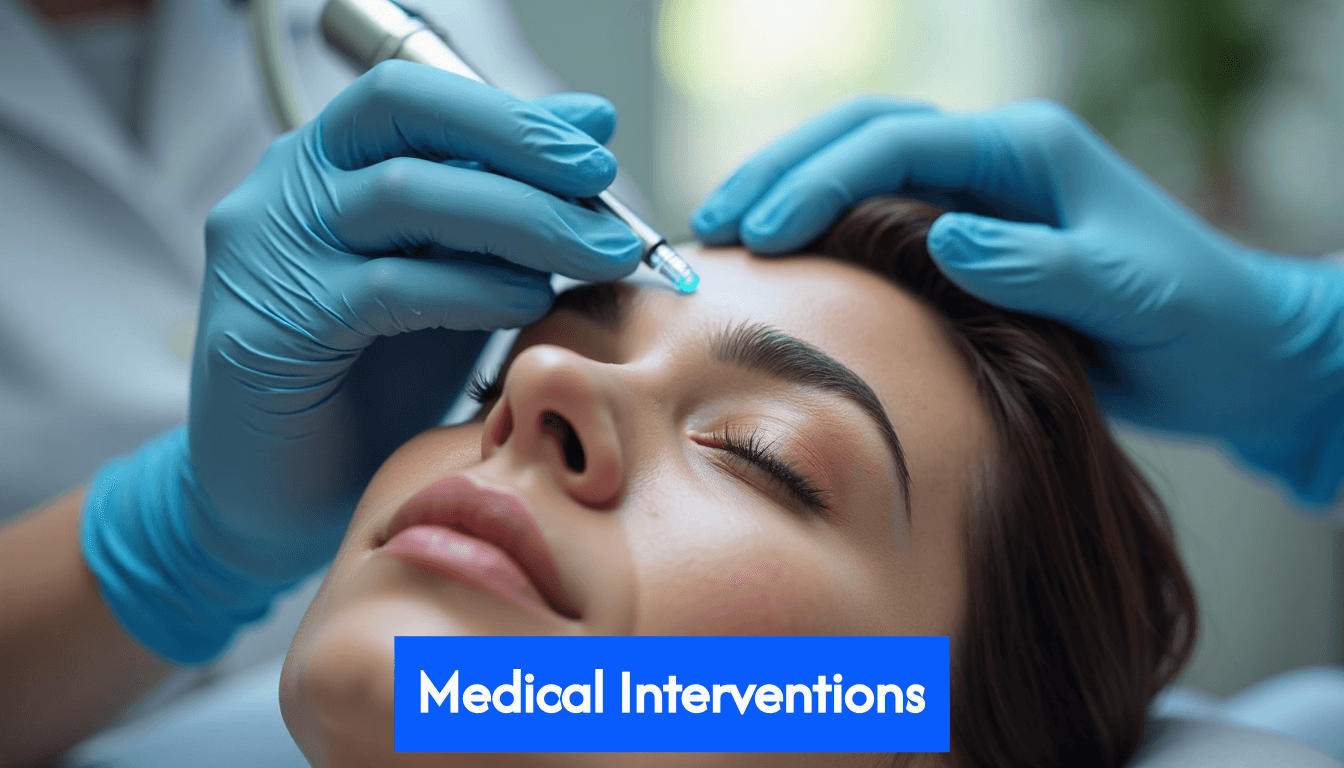Blog
Learning Materials
Top Hair Thinning Problem Solutions for 2025: Expert Tips
Updated: June 18, 2025

Hair thinning is not just a worry for a few people anymore. By age 65, about 53 percent of men and 37 percent of women face some level of baldness. That number shocks most and hints at how common the problem has become. Yet, while most expect genetics to be the uncontrollable villain, there is a twist. Many people can actually slow or even reverse thinning through a mix of science-driven treatments and daily habits that put newer technology to work for them. Here is how 2025 is changing the story for anyone concerned about their hair.
Table of Contents
- What Causes Hair Thinning And Loss?
- Best Solutions For Hair Thinning Problems
- How To Track And Boost Hair Growth Progress
- Personalized And Professional Hair Care Options
Quick Summary
| Takeaway | Explanation |
|---|---|
| Genetics Are Key | Approximately 53% of men and 37% of women experience some form of baldness by age 65 due to genetic predisposition, particularly sensitivity to DHT. |
| Lifestyle Impacts Hair Health | Poor nutrition, stress, pollution, and harsh grooming practices significantly contribute to hair thinning; focus on a balanced diet and stress management. |
| Explore Multiple Treatment Options | Effective solutions range from pharmaceutical treatments like Minoxidil and Finasteride to advanced medical procedures and holistic lifestyle approaches. |
| Track Your Progress | Utilize advanced technologies such as AI-powered diagnostic tools and regular assessments to efficiently monitor hair growth and adjust strategies accordingly. |
| Personalization is the Future | Engage with personalized hair care products and professional consultations that leverage individual genetic and lifestyle factors for optimized hair health solutions. |
What Causes Hair Thinning and Loss?
Hair thinning and loss represent complex biological processes affecting millions worldwide. Understanding the root causes is crucial for developing effective hair thinning problem solutions.
Genetic Predisposition: The Primary Culprit
Genetics play a significant role in hair loss, with androgenetic alopecia being the most common form. Our detailed analysis on female hairline changes reveals that genetic factors can determine hair loss patterns from an early age. According to research, by age 65, approximately 53% of men and 37% of women will experience some form of baldness.
The genetic component involves sensitivity to dihydrotestosterone (DHT), a hormone that shrinks hair follicles. Individuals with a family history of hair loss are more likely to experience similar patterns. This genetic blueprint determines how susceptible your hair follicles are to hormonal changes and miniaturization.
Lifestyle and Environmental Factors
Modern lifestyle significantly impacts hair health. Stress, poor nutrition, environmental pollution, and harsh grooming practices contribute to hair thinning. Research from global health studies indicates that approximately 35 million men and 21 million women worldwide experience hair loss related to these factors.
Key lifestyle influences include:
- Nutritional Deficiencies: Lack of essential nutrients like protein, iron, and vitamins can trigger hair loss
- Chronic Stress: Prolonged stress disrupts hair growth cycles
- Environmental Toxins: Pollution and chemical exposures damage hair follicles
- Inappropriate Hair Care: Excessive heat styling and harsh chemical treatments
Medical Conditions and Hormonal Changes
Underlying medical conditions frequently contribute to hair thinning. Thyroid disorders, autoimmune diseases, and hormonal imbalances can dramatically impact hair growth. Conditions like alopecia areata cause sudden hair loss, while hormonal changes during pregnancy, menopause, or thyroid dysfunction can trigger temporary or permanent hair thinning.
Hormonal shifts play a critical role. During significant life stages such as postpartum periods or menopause, dramatic hormonal changes can cause temporary or permanent hair loss. Medications for various health conditions can also inadvertently trigger hair thinning as a side effect.
Understanding these multifaceted causes empowers individuals to take proactive steps in managing and potentially reversing hair thinning. While some factors remain beyond personal control, many hair thinning problem solutions exist to address these challenges effectively.

Best Solutions for Hair Thinning Problems
Addressing hair thinning requires a comprehensive and personalized approach. With advancing medical technologies and innovative treatments, individuals now have multiple effective strategies to combat hair loss and promote healthy hair growth.
Pharmaceutical and Topical Treatments
Pharmaceutical interventions remain at the forefront of hair thinning solutions. Our comprehensive guide to hair growth methods highlights several proven pharmaceutical approaches. Minoxidil and finasteride stand as the most widely prescribed treatments.
Minoxidil, available as a topical solution, stimulates hair follicle activity and improves blood circulation to the scalp. According to research from leading dermatological institutes, patients typically observe results within 3 to 6 months of consistent application. Finasteride, an oral medication, works by blocking DHT hormone production, which directly contributes to hair miniaturization.
Emergent treatments like JAK inhibitors represent a promising frontier. Cutting-edge research suggests these new drug classes could revolutionize hair loss management for conditions previously considered challenging to treat.
Advanced Medical Interventions
For more aggressive hair thinning, medical procedures offer sophisticated solutions. Platelet-rich plasma (PRP) therapy has gained significant traction. This treatment involves extracting a patient's blood, processing it to concentrate platelets, and then reinjecting it into the scalp to stimulate hair growth.
Hair transplantation techniques have also dramatically improved. Robotic hair transplant technologies now provide precise, minimally invasive procedures with natural-looking results. These advanced techniques allow for more accurate follicle extraction and reimplantation, reducing recovery time and improving aesthetic outcomes.
Holistic and Lifestyle Approaches
Beyond medical interventions, holistic strategies play a crucial role in managing hair thinning. Nutrition significantly impacts hair health. Diets rich in proteins, iron, vitamins (especially biotin), and omega-3 fatty acids support robust hair growth. Low-level laser therapy (LLLT) offers a non-invasive approach, using specific light wavelengths to stimulate follicular activity.

Stress management and proper hair care routines complement medical treatments. Gentle hair handling, avoiding excessive heat styling, and using sulfate-free products can prevent further hair damage. Regular scalp massages improve blood circulation, potentially supporting hair follicle health.
The landscape of hair thinning solutions continues to evolve rapidly. While no universal solution exists, a combination of targeted treatments, lifestyle modifications, and professional guidance can significantly mitigate hair thinning challenges. Consulting with healthcare professionals remains the most effective strategy for developing a personalized hair restoration plan.
How to Track and Boost Hair Growth Progress
Tracking hair growth progress has transformed dramatically with technological advancements, offering individuals unprecedented insights into their hair health and growth potential. Modern approaches combine sophisticated diagnostic tools with personalized strategies to monitor and enhance hair development.
Advanced Tracking Technologies
Our innovative hair growth tracking guide reveals how AI-powered diagnostic technologies now enable microscopic precision in monitoring hair density and follicle health. These cutting-edge tools provide real-time insights through comprehensive mapping and predictive modeling, allowing users to visualize their hair growth journey with unprecedented accuracy.
Key technological tracking methods include:
- Digital Scalp Imaging: High-resolution cameras capture detailed follicle measurements
- AI Analysis: Advanced algorithms assess hair thickness, density, and growth patterns
- Comparative Tracking: Periodic scans create visual progression timelines
- Predictive Modeling: Forecasting potential hair growth scenarios based on current data
Holistic Growth Enhancement Strategies
Beyond technological tracking, effective hair growth requires a multifaceted approach. Research from global hair health experts emphasizes the importance of integrating lifestyle factors with technological insights. Nutrition plays a critical role in supporting robust hair growth. Protein-rich diets, adequate hydration, and supplements containing biotin, iron, and vitamins contribute significantly to hair health.
Stress management emerges as another crucial component. Chronic stress disrupts hair growth cycles, potentially accelerating hair thinning. Techniques like meditation, regular exercise, and consistent sleep patterns can help mitigate stress-related hair loss. Professional counseling or stress reduction programs might provide additional support for individuals experiencing significant hair growth challenges.
Personalized Intervention and Monitoring
Personalization represents the future of hair growth tracking. Modern approaches go beyond generic solutions, leveraging individual genetic profiles, lifestyle data, and technological assessments to create tailored hair restoration plans. Regular consultations with trichologists or dermatology specialists enable ongoing refinement of growth strategies.
Documenting progress becomes crucial. Maintaining a detailed log of treatments, lifestyle changes, and technological scan results helps individuals and healthcare professionals understand what interventions are most effective. Monthly or quarterly assessments allow for quick adjustments to hair growth strategies, ensuring optimal results.
The intersection of technology, personalized medicine, and holistic health approaches offers unprecedented opportunities for individuals struggling with hair growth challenges. By embracing comprehensive tracking methods and targeted interventions, users can gain meaningful insights and take proactive steps toward achieving their hair health goals.
Personalized and Professional Hair Care Options
The hair care landscape is undergoing a revolutionary transformation, with personalized solutions becoming the cornerstone of modern hair health management. Technological advancements and data-driven approaches are reshaping how individuals address their unique hair thinning challenges.
Advanced Personalization Technologies
Our comprehensive holistic hair care guide highlights the emerging trend of hyper-personalized hair care solutions. According to market research, the personalized hair care market is projected to reach $5 billion in 2025, growing at an impressive 15% compound annual growth rate.
Key personalization technologies include:
- AI-Powered Diagnostic Tools: Advanced algorithms analyze individual hair characteristics
- Genetic Profile Assessments: Tailored recommendations based on genetic predispositions
- Environmental Factor Analysis: Customized solutions accounting for lifestyle and environmental impacts
- Digital Hair Health Tracking: Real-time monitoring and adaptive treatment recommendations
Professional Consultation and Treatment Options
Professional hair care has evolved beyond traditional approaches. Trichologists and specialized dermatologists now offer comprehensive diagnostic services that go far beyond surface-level treatments. Global market insights indicate the hair care market will expand from $96.7 billion in 2025 to $128.7 billion by 2034, reflecting the growing demand for specialized solutions.
Professional interventions now include:
- Comprehensive Scalp Diagnostics: Microscopic analysis of hair and scalp health
- Precision Treatment Protocols: Targeted interventions based on individual assessments
- Advanced Therapeutic Techniques: Including PRP therapy, scalp micropigmentation, and regenerative treatments
- Ongoing Monitoring and Adjustment: Periodic reassessments to optimize hair growth strategies
Direct-to-Consumer Personalized Solutions
The rise of direct-to-consumer (DTC) personalized hair care brands represents a significant innovation in the industry. These brands leverage advanced technology and data analysis to create precise, individualized hair care formulations. Consumers can now participate actively in their hair care regimen through detailed online assessments that capture nuanced information about hair type, lifestyle, and specific concerns.
Key elements of DTC personalization include:
- Comprehensive Online Assessments: Detailed questionnaires capturing individual hair characteristics
- Custom Formulation Technologies: Precise product creation based on individual needs
- Subscription-Based Adaptive Care: Ongoing product refinement based on user feedback
- Digital Consultation Services: Expert guidance accessible through digital platforms
The future of hair care is unequivocally personalized. By combining cutting-edge technology, professional expertise, and individual-focused approaches, these innovative solutions offer unprecedented hope for individuals struggling with hair thinning. The convergence of AI, genetic analysis, and professional medical insights creates a new paradigm of hair health management that is more effective, precise, and tailored than ever before.
Frequently Asked Questions
What causes hair thinning and loss?
Hair thinning can be caused by genetic predisposition, lifestyle factors (such as stress and poor nutrition), and medical conditions, including hormonal changes and autoimmune diseases. Genetics, particularly sensitivity to the hormone DHT, is a primary factor.
What are the best treatments for hair thinning in 2025?
Effective treatments for hair thinning include pharmaceutical options like Minoxidil and Finasteride, advanced medical interventions such as PRP therapy and hair transplants, and holistic lifestyle approaches focusing on nutrition and stress management.
How can I track my hair growth progress?
You can track hair growth using advanced technologies like digital scalp imaging and AI analysis, which provide insights into hair density and follicle health. Keeping a detailed log of your treatments and growth can also help you monitor your progress.
What are personalized hair care solutions?
Personalized hair care solutions involve using advanced technologies that consider your individual genetic profile, lifestyle, and hair characteristics to create tailored treatment plans. Direct-to-consumer brands now offer customized hair care products based on detailed assessments.
Take Control of Your Hair Growth Journey in 2025
Struggling with unpredictable hair thinning and frustrated by generic advice that never quite fits your needs? You are not alone. This article highlighted how genetics, lifestyle, and stress can leave your hair feeling sparse and your confidence shaken. The next step is precise: it is time to stop guessing and start knowing. Get clear, personalized insights into your unique hair patterns with a cutting-edge approach designed just for you. Discover the power of AI-based analysis and see exactly where you stand—so you can finally move forward.

Ready to see real progress? Upload your scans and let MyHair.ai do all the analysis. Instantly get personalized product recommendations and growth projections based on what your hair truly needs. No more one-size-fits-all solutions. Experience your best hair in 2025 today. Act now to take the first step toward fuller, healthier hair!